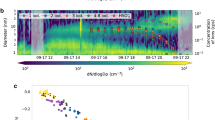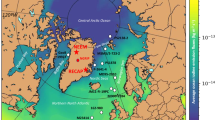Abstract
Arising from: C. O'Dowd et al. Nature 417, 632–636 (2002); see O'Dowd et al. reply. O'Dowd et al.1 describe the formation of marine aerosols from biogenic iodine and the growth of these aerosols into cloud-condensation nuclei (CCN). Based on chamber and modelling results, the authors suggest that biogenic organic iodine compounds emitted from macroalgae may be responsible for coastal particle bursts and that production of these compounds in the open ocean could increase CCN there too. It has since been shown that coastal particles are more likely to be produced from the photooxidation of molecular iodine2. Moreover, I contend that open-ocean particle production and cloud enhancement do not result from emissions of organic iodine at atmospheric levels. For iodine particles to affect cloud properties over the remote ocean, an additional source of iodine is necessary as organic precursors cannot be responsible.
Similar content being viewed by others
Main
O'Dowd et al. propose that, in the presence of ozone, photolysis of atmospheric iodocarbons emitted from marine algae is a viable mechanism for the coastal production of new particles. This follows directly from observations relating aerosol formation and macroalgal iodocarbon emissions3 to the tidal cycle. However, particles formed by a variety of methods2 have the same composition as those formed in the chamber study of O'Dowd et al.1. The methods tested include exposing various Laminaria species to ambient and higher levels of ozone; mixing ozonized air with ozone-free air that has been passed over macroalgae; or exposing molecular iodine vapour (I2) to ozone2. The Laminaria macroalgae species are among those responsible for coastal iodine emissions.
Iodine-atom fluxes from an inorganic source, such as gaseous iodine4, have been shown to dominate2 those from the organic compound diiodomethane (CH2I2; the most photolabile iodocarbon in the coastal environment and the one used by O'Dowd et al. in their chamber). Iodine-atom flux from atmospheric I2 greatly exceeds that derived from the lowest CH2I2 concentrations used in the chamber experiments of O'Dowd et al., which were more than an order of magnitude higher than atmospheric levels. Coastal iodine-containing particles are therefore much more likely to be formed from I2 than from CH2I2.
Particle bursts have been measured at Mace Head in Galway, Ireland, alongside iodocarbon fluxes. The phenomena are characterized by extremely high concentrations and production rates of 3-nm-diameter particles5. Some have deduced6 that the precursor vapour sources are biologically rich tidal regions, tens to hundreds of metres from the measuring location (or tens of ‘transit seconds’). On these timescales, average atmospheric CH2I2 concentrations, which are two orders of magnitude lower than those in the smog chamber1, would not be able to form the observed 104 to 106 particles cm−3. And yet for the laboratory mechanism to work in the coastal atmosphere, nucleation and growth characteristics must behave in the same way.
O'Dowd et al. used a model to demonstrate nanometre-scale sulphate-cluster stabilization by condensation of condensable iodine vapours (CIVs) and a consequent increase in CCN number. Their concentrations of CIVs are consistent with unrepresentatively low source estimates from a model7 that is aimed at explaining open-ocean iodine monoxide observations8. By assuming that CH2I2 is the coastal atmospheric iodine source, the model successfully replicates coastal observations7. However, coastal iodine-atom production from I2 that is associated with an iodine monoxide mixing ratio of a few parts per trillion is about 5×107 cm−3 s−1, and not 1×104 cm−3 s−1 as calculated from CH2I2.
Assuming a common chemical mechanism, the open-ocean iodine-atom production that is required to explain the observed remote marine iodine monoxide must be much higher than that proposed by O'Dowd et al. To achieve this rate, however, a further remote marine-atmospheric iodine source must be found (abiotic production9, for example), as the original flux estimate is consistent with the observed open-ocean organic iodine. At increased concentrations, iodine oxides may nucleate in the absence of pre-existing clusters1,2, a mechanism that could explain the coastal phenomenon and possibly play a part in the open ocean. There is little evidence to support sulphate nucleation in the marine boundary layer following dimethylsulphide oxidation, hence the existence of pre-existing sulphate clusters should not be relied upon to explain marine-iodine enhancement of CCN. The identity of CIVs and their role in aerosol and CCN formation are unclear, as are their production rates as a function of an enhanced iodine-atom source. Taken together, all this calls for an improved understanding of the key species and processes involved in aerosol nucleation and growth in the marine boundary layer.
References
O'Dowd, C. et al. Nature. 417, 632–636 (2002).
McFiggans, G. et al. Atmos. Chem. Phys. 4, 1–13 (2004).
Carpenter, L. J. J. Geophys. Res. 104, 1679–1689 (1999).
Saiz-Lopez, A. & Plane, J. M. C. Geophys. Res. Lett. 31, L04112 (2004).
O'Dowd, C. et al. Geophys. Res. Lett. 26, 1707–1710 (1999).
O'Dowd, C. et al. Atmos. Res. 58, 167–185 (2001).
McFiggans, G. et al. J. Geophys. Res. 105, 14371–14385 (2000).
Allan, B. J., McFiggans, G., Plane, J. M. C. & Coe, H. J. Geophys. Res. 105, 14361–14369 (2000).
Garland, J. A. & Curtis, H. J. Geophys. Res, 86, 3183–3186 (1981).
Author information
Authors and Affiliations
Corresponding author
Rights and permissions
About this article
Cite this article
McFiggans, G. Marine aerosols and iodine emissions. Nature 433, E13 (2005). https://doi.org/10.1038/nature03372
Published:
Issue Date:
DOI: https://doi.org/10.1038/nature03372
This article is cited by
-
Measurement of IO radical concentrations in the marine boundary layer using a cavity ring-down spectrometer
Journal of Atmospheric Chemistry (2007)
-
Marine aerosols and iodine emissions (Reply)
Nature (2005)
Comments
By submitting a comment you agree to abide by our Terms and Community Guidelines. If you find something abusive or that does not comply with our terms or guidelines please flag it as inappropriate.



